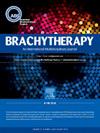高剂量率(HDR)近距离放疗与外束放疗联合治疗局限性前列腺癌:基于证据的共识声明
IF 1.8
4区 医学
Q4 ONCOLOGY
引用次数: 0
摘要
目的:本指南提出了高剂量率(HDR)近距离增强治疗联合外束放疗(EBRT)治疗局限性前列腺癌的循证共识建议。方法和材料:美国近距离放疗协会召集了一个工作组,讨论有关前列腺HDR近距离放疗与EBRT联合用于局限性前列腺癌的主要治疗的关键问题。我们进行了全面的文献检索,以确定涉及HDR近距离治疗联合EBRT的前瞻性和大型回顾性研究。研究结果包括生化和/或疾病控制、毒性、患者报告的生活质量以及雄激素剥夺治疗的作用。结果:Ir-192联合EBRT的HDR近距离治疗对于中高危前列腺癌患者是一种合适的治疗选择。CT、超声和/或MRI是可用于治疗计划和交付的成像平台。单个植入物/剂量为15 Gy或2个植入物/剂量为9.5-11 Gy均可与EBRT联合使用,剂量相当于45-50.4 Gy,剂量为1.8-2.0 Gy。与单独增加剂量的EBRT相比,加入HDR近距离放疗有望改善生化控制。HDR近距离放射治疗增强有望达到与低剂量率(LDR)近距离放射治疗增强相似的生化控制结果。雄激素剥夺治疗推荐给患有不利的中高危疾病的男性,治疗时间根据癌症风险不同而不同。与LDR永久种子相比,使用HDR近距离治疗技术在治疗后具有更小的急性泌尿生殖系统(GU)和胃肠道(GI)毒性。结论:对于中高危前列腺癌患者,HDR近距离强化治疗是一种安全有效的剂量递增技术,与单独EBRT相比,HDR近距离强化治疗可以实现更好的生化控制,与LDR近距离治疗技术相比,可能具有改善的GU和GI副作用。本文章由计算机程序翻译,如有差异,请以英文原文为准。
High-dose-rate (HDR) brachytherapy boost in combination with external beam radiotherapy for localized prostate cancer: An evidence-based consensus statement
PURPOSE
This guideline presents evidence-based consensus recommendations for high-dose-rate (HDR) brachytherapy boost in combination with external beam radiotherapy (EBRT) for the primary treatment of localized prostate cancer.
METHODS AND MATERIALS
The American Brachytherapy Society convened a task force for addressing key questions concerning prostate HDR brachytherapy boost with EBRT for the primary treatment of localized prostate cancer. A comprehensive literature search was conducted to identify prospective and large retrospective studies involving HDR brachytherapy combined with EBRT. Outcomes of interest included biochemical and/or disease control, toxicity, patient-reported quality of life, and the role of androgen deprivation therapy.
RESULTS
HDR brachytherapy using Ir-192 in combination with EBRT is an appropriate treatment option for men with intermediate- and high-risk prostate cancer. CT, ultrasound, and/or MRI are imaging platforms that may be utilized for treatment planning and delivery. A single implant/fraction of 15 Gy or 2 implants/fractions of 9.5-11 Gy each are acceptable regimens in combination with EBRT at a dose equivalent of 45-50.4 Gy in 1.8-2.0 Gy fractions. The addition of HDR brachytherapy is expected to improve biochemical control compared with dose escalated EBRT alone. HDR brachytherapy boost is expected to achieve similar biochemical control outcomes as a low dose rate (LDR) brachytherapy boost. Androgen deprivation therapy is recommended for men with unfavorable intermediate and high-risk disease, with varying duration dependent on cancer risk. Use of an HDR brachytherapy technique, as opposed to LDR permanent seeds, has been shown to have less acute genitourinary (GU) and gastrointestinal (GI) toxicity following treatment.
CONCLUSIONS
For men with intermediate- and high-risk prostate cancer, HDR brachytherapy boost is a safe and effective technique for dose-escalation that can achieve superior biochemical control compared with EBRT alone, possibly with an improved GU and GI side effect profile compared with an LDR brachytherapy technique.
求助全文
通过发布文献求助,成功后即可免费获取论文全文。
去求助
来源期刊

Brachytherapy
医学-核医学
CiteScore
3.40
自引率
21.10%
发文量
119
审稿时长
9.1 weeks
期刊介绍:
Brachytherapy is an international and multidisciplinary journal that publishes original peer-reviewed articles and selected reviews on the techniques and clinical applications of interstitial and intracavitary radiation in the management of cancers. Laboratory and experimental research relevant to clinical practice is also included. Related disciplines include medical physics, medical oncology, and radiation oncology and radiology. Brachytherapy publishes technical advances, original articles, reviews, and point/counterpoint on controversial issues. Original articles that address any aspect of brachytherapy are invited. Letters to the Editor-in-Chief are encouraged.
 求助内容:
求助内容: 应助结果提醒方式:
应助结果提醒方式:


